I think most readers would agree that lithium (“Li“) prices bottomed in September at ~71,500 yuan/tonne (see chart below). That’s the good news. The not-so-good news is the price has barely moved off its lows, just +5.6% to 75,500 yuan/t –> ~US$10,750/t.
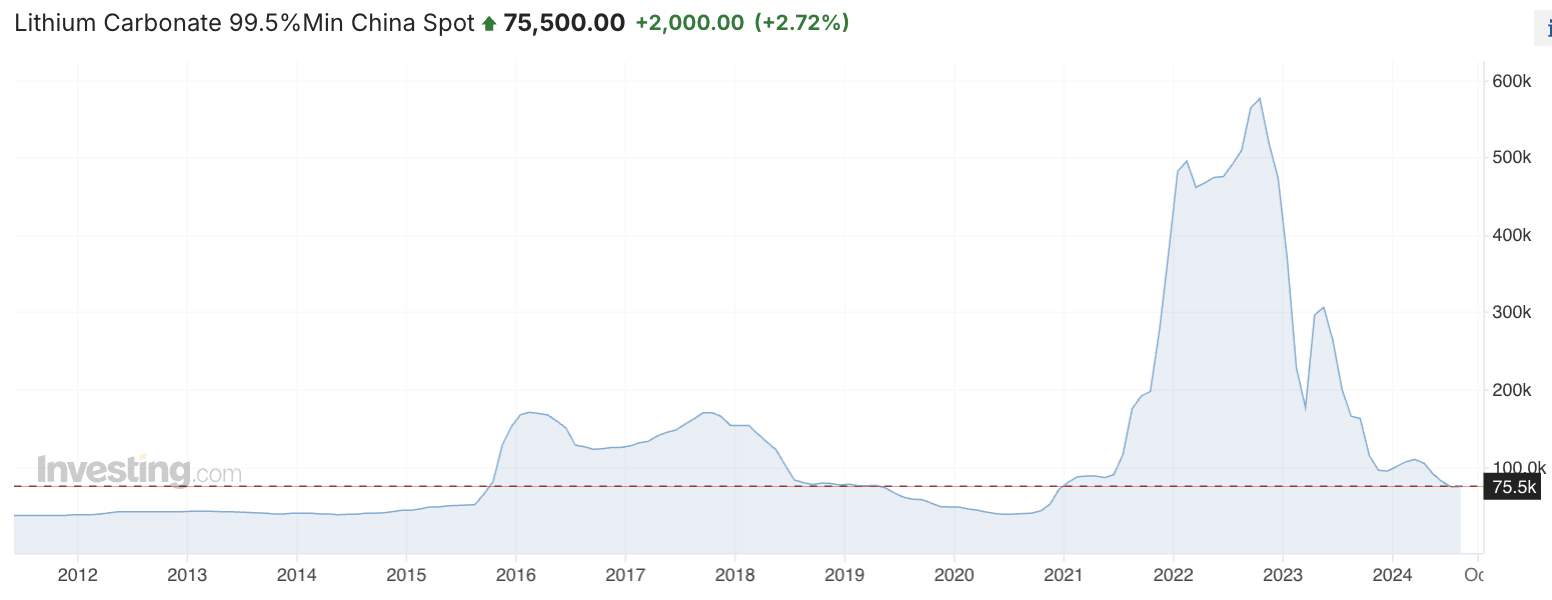
A few investment banks are now saying battery-quality Li carbonate & spodumene concentrate (“SC“) prices might bounce +25%. That would be nice, but there’s a pink elephant in the room… Over 20 PEA, PFS & DFS reports have been done this decade with long-term SC assumptions of > $2,000/t, for sub-6% SC.
SC 6% today is < $800/t, even if it rises +25% it would still be < $1,000/t. Something has to give, either there won’t be enough Li for the batteries needed to transition away from fossil fuels, or the Li price will rise. There’s no middle ground. Most early-stage projects the world urgently needs next decade won’t get funded with S6 6% below US$1,500/t.
That doesn’t mean the Li price will spike next month or quarter, but in the next 1-2 years I see a return to $20-$25,000+ LCE, and $2,000-$2,500 SC 6%. In the meantime, advanced-stage projects, in attractive jurisdictions, with low-cost structures, are well-positioned to continue marching forward.

One such company is Lithium Ionic. Like peers, its SC 5.5% assumption is well above current levels. Over a 14-yr. mine the average is $2,277/t, but, the 100%-owned flagship Bandeira project’s average price in years 1 to 6 is $1,559/t. Importantly, Lithium Ionic’s cost per tonne of SC 5.5% is just $444. That cost figure is comfortably in the bottom quartile.
In fact, $444/t as of mid-2024 might be in the bottom decile of costs because peer project PEA, PFS, and BFS reports done 12-36 months ago are stale. There has been significant cost inflation since 2020-21. Lithium Ionic says it could operate profitably even at today’s sub-$800/t levels.
Lithium Ionic is cashed up with over C$35M after a string of good news. On May 29th & 30th, the Company announced the results of a Bank Feasibility Study (“BFS“) and the signing of a term sheet for a 2.5% gross revenue royalty royalty transaction, subsequently closed, for US$20M in July.

The following week, management agreed to acquire the remaining 15% of select Salinas properties and announced (and later closed) a $15M private placement at a premium to market, with only a half warrant. These de-risking events highlight the strength of management, the balance sheet & the Bandeira project.
In mid-August, earlier stage Brazilian neighbor Latin Resources agreed to be acquired by Australian bellwether Pilbara Minerals. Latin’s share price is up +92% in the past six weeks. It would be hard to overstate the significance of this transaction. First, it’s a robust vote of confidence in Brazil’s hard rock Li sector.
Making good progress on the permitting front…
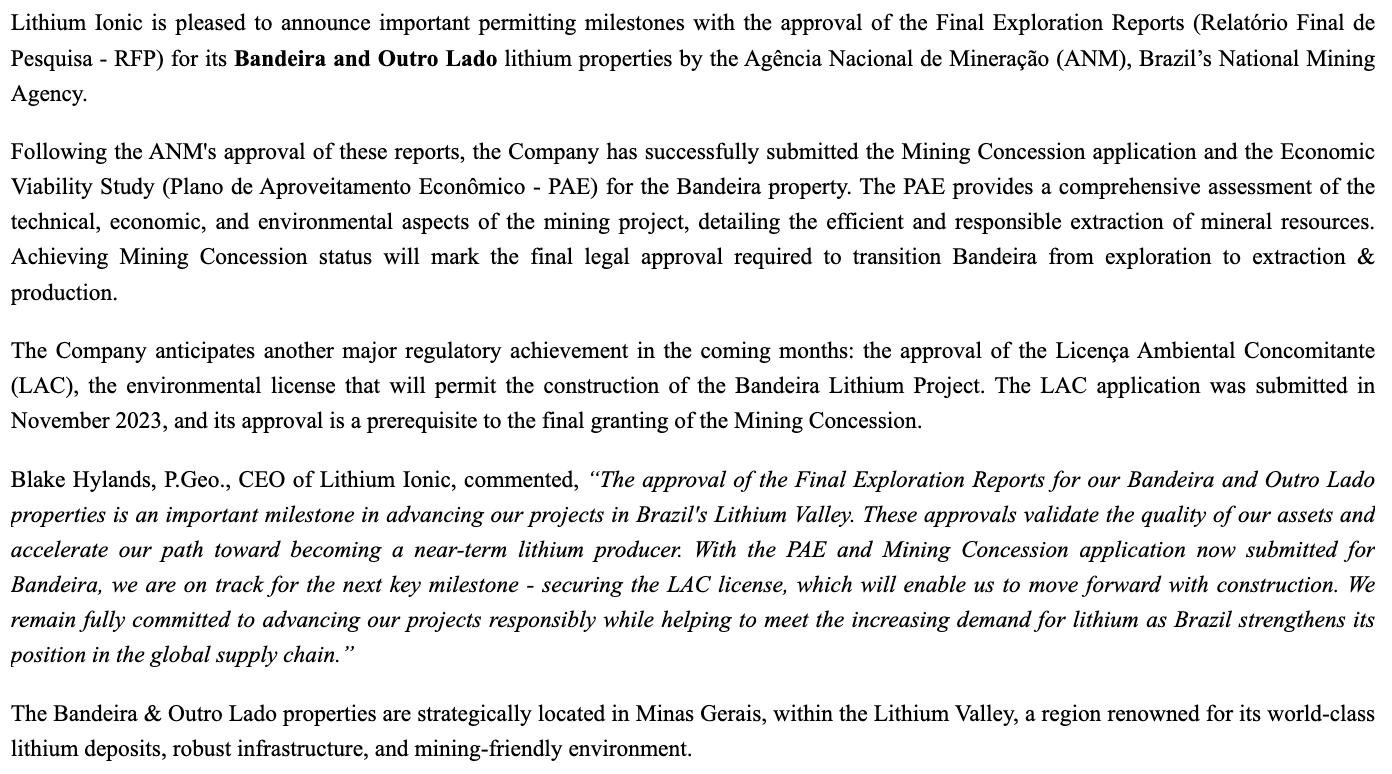
Pilbara could have gone to Canada, the U.S., Europe, or Africa to acquire its first major asset outside of Australia. Pilbara’s CEO said,
“The acquisition follows an extensive period of project assessment globally in which we ranked Latin Resources’ Salinas project at the top of our list when benchmarked holistically across a range of key criteria.”
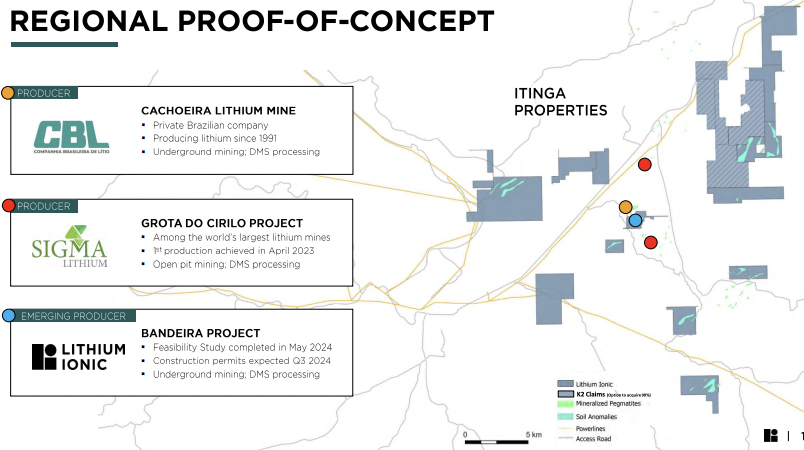
It’s telling that one of the largest Li producers, with operations in Australia, looked around the world for over a year and ended up in Brazil. Having Pilbara next door will attract other multi-billion dollar companies to Minas Gerais. Pilbara’s bold move signals that now’s a great time to pursue world-class Li projects.
I mentioned that Li prices probably bottomed… and something else happened –> China announced a large stimulus package (with more to follow) to boost its financial sector and revive the economy. Chinese stocks & global copper prices soared. This will bolster EV sales and be positive for Li prices.
Lithium Ionic has two much larger companies nearby, Pilbara & Sigma Lithium. Those companies’ projects/mine expansions will deliver very valuable regional infrastructure –> skilled mining labor, equipment & services, roads, housing, power, water, rail, high-speed internet, etc.
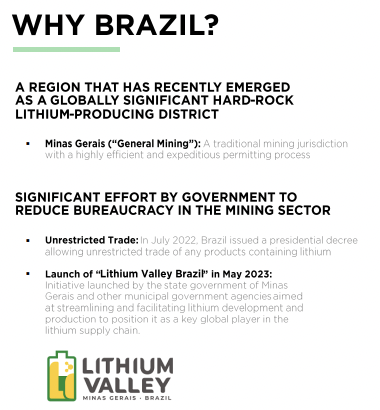
Some companies are up a lot in the past month, Critical Elements, Q2 Metals, ioneer ltd., and Power Metals are up an average of +36%. In my view, Lithium Ionic remains very undervalued vs. three main peers Sigma Lithium, Latin Resources, and Atlas Lithium, all with significant Li assets in Brazil.
As a successful & growing producer, Sigma is ~3.5 years ahead of Lithium Ionic and deserves to trade at a meaningful premium. However, the valuation gap of 26x is simply too high. I think it should be more like half that, 13x. All else equal, the Company’s stock would have to rise +70% to lower the valuation gap to 13x.
Admittedly that 13x is subjective, so let me throw another metric in, where, coincidentally, the #13 pops up again. Sigma is valued at $578/ tonne of LCE vs. Lithium Ionic at just $44/t. [$578/$44 = 13x). Is Sigma worth 13x more on an EV/LCE basis?
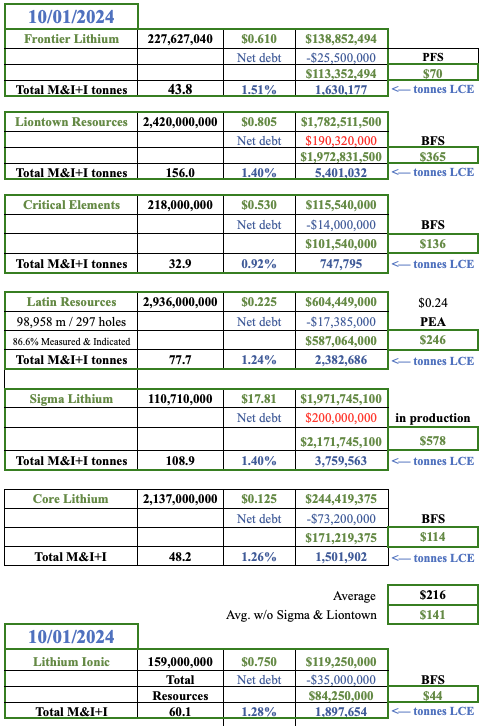
In the relative value chart above, the Company is valued at a 69% discount to peers (not including Sigma & Liontown Resources). The Company’s enterprise value {market cap + debt – cash] of $84M is just 6% of the after-tax NPV of the Bandeira project. Peer junior mining projects at BFS-stage are valued at 20%-40% of NPV.
Sigma has blazed a path forward, from maiden resource to production in just five years. The permitting times in Brazil are much shorter than in Canada & western Australia.
I wonder if Sigma has considered trying to acquire Lithium Ionic? A combined Sigma/Lithium Ionic would be highly attractive to a company like Pilbara Minerals, SQM, Albemarle, Rio Tinto, Vale, Mineral Resources (“MinRes”), Stellantis, POSCO, Fortescue Metals, Glencore, privately-held Hancock Prospecting, Sumitomo, Hanwa, Mitsubishi or Mitsui & Co.
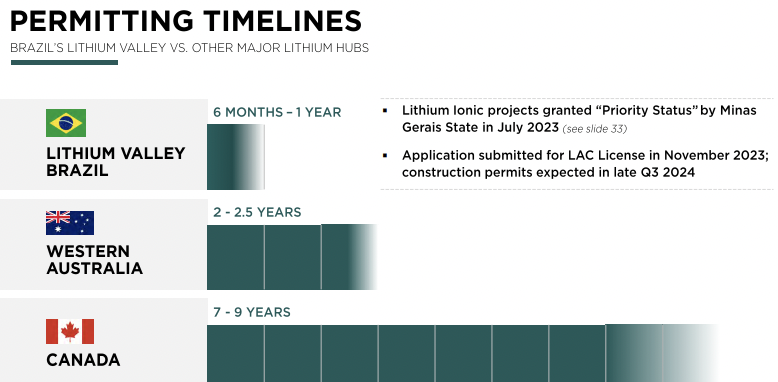
Why do I list four Japanese trading houses? All four have made direct investments into Li projects or companies. Mitsui & Co. invested in Atlas Lithium, an early stage (pre-maiden resource) junior, with a project in Brazil. Stellantis has a direct investment in a Li junior in Argentina, and other Auto or battery OEMs should care.
For geopolitical reasons, I did not include Chinese groups, of which there would be many. Ok, enough about Sigma. Let’s compare the Company to Latin Resources. Latin has a great project, which is why Pilbara is acquiring it.
It’s at PEA-stage vs. Lithium Ionic with a BFS. Latin has a moderately larger resource at 78M tonnes vs. 60M tonnes, and the 78M tonnes is in one big open pitable resource. Lithium Ionic has a slightly higher grade at 1.28% Li20 vs. 1.24%.
The problem with Latin? It’s being acquired, so it’s fully valued at C$579M, 7x that of Lithium Ionic at $84M. On an EV/LCE basis, Latin is 5x higher. Atlas also has a strong project, but it is pre-MRE and has a larger valuation than the Company.
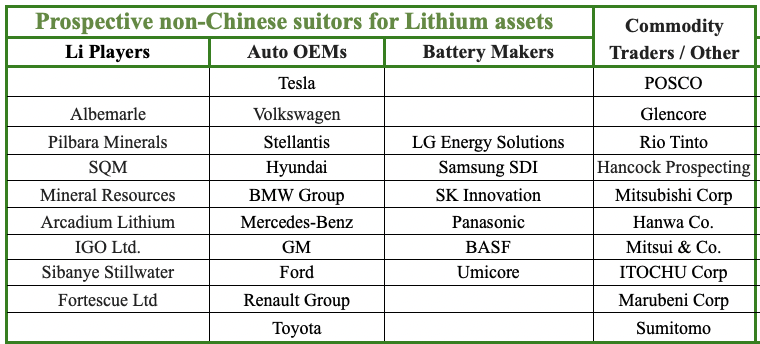
The bottom line is that Sigma, Latin, Atlas & Lithium Ionic are well-positioned in Brazil with sizable, growing, high-grade Li assets. Of the four, Lithium Ionic stands out for being very cheaply valued on an absolute & relative basis. As the Li market rebounds, dozens of companies may be looking for Li assets in Brazil, they have only three meaningful ones to choose from.
If Sigma is acquired next year, all eyes will be on just Lithium Ionic & Atlas Lithium. One has a BFS on it, the other is a pre-maiden resource play. Atlas has strategic backing, but Lithium Ionic is wide open for a strategic investor like the ones in the chart above. Readers are encouraged to review Lithium Ionic’s new Corporate Presentation.
Disclosures/disclaimers: The content of this article is for information only. Readers fully understand and agree that nothing contained herein, written by Peter Epstein of Epstein Research [ER], (together, [ER]) about Lithium Ionic, including but not limited to, commentary, opinions, views, assumptions, reported facts, calculations, etc. is not to be considered implicit or explicit investment advice. Nothing contained herein is a recommendation or solicitation to buy or sell any security. [ER] is not responsible under any circumstances for investment actions taken by the reader. [ER] has never been, and is not currently, a registered or licensed financial advisor or broker/dealer, investment advisor, stockbroker, trader, money manager, compliance or legal officer, and does not perform market-making activities. [ER] is not directly employed by any company, group, organization, party, or person. The shares of Lithium Ionic are highly speculative, and not suitable for all investors. Readers understand and agree that investments in small-cap stocks can result in a 100% loss of invested funds. It is assumed and agreed upon by readers that they will consult with their own licensed or registered financial advisors before making investment decisions.
At the time this article was posted, Lithium Ionic was an advertiser on [ER] and Peter Epstein owned shares in the company purchased in the open market.
Readers understand and agree that they must conduct due diligence above and beyond reading this article. While the author believes he’s diligent in screening out companies that, for any reason whatsoever, are unattractive investment opportunities, he cannot guarantee that his efforts will (or have been) successful. [ER] is not responsible for any perceived, or actual, errors including, but not limited to, commentary, opinions, views, assumptions, reported facts & financial calculations, or for the completeness of this article or future content. [ER] is not expected or required to subsequently follow or cover events & news, or write about any particular company or topic. [ER] is not an expert in any company, industry sector or investment topic.
![Epstein Research [ER]](https://epsteinresearch.com/wp-content/uploads/2025/02/logo-ER.jpg)

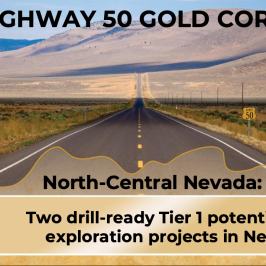
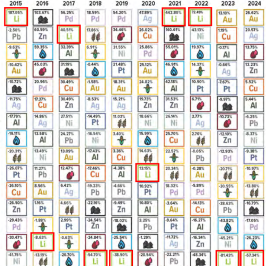



Leave a Reply